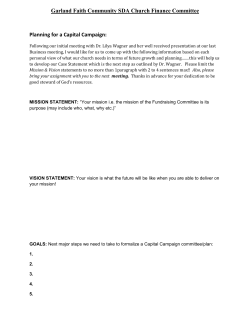
Make your election campaign inclusive of people
Make your election campaign inclusive of people with speech, language and communication needs Advice to candidates in the 2015 Westminster Elections An estimated 2.5 million people in the UK have speech, language and communication needs (SLCN). This number includes adults with hearing impairment, dyslexia, a third of stroke survivors, people who have had head and neck cancers and people who use “talking machines” (like that used by Stephen Hawking) including people with MS, MND and cerebral palsy. A significant number of people with SLCN are eligible to vote. Speech and Language Therapists (SLT) are experts in enabling people to communicate effectively with those with SLCN. This short, basic, general guide aims to support all candidates to communicate more effectively with the voting public who have SLCN. 5 Communication Support Principlesi Principle 1: Recognise that every community or group may include people with communication support needs. Expect to meet people with SLCN and be prepared. Principle 2: Find out what support is required. If you become aware someone is having difficulty understanding or expressing themselves ask what you can do to help. Principle 3: Match the way you communicate to the ways people understand. Principle 4: Respond sensitively to all the ways an individual uses to express themselves. Principle 5: Give people the time and space to communicate to the best of their abilities. Putting Communication Principles into Your Election Campaign Practice Face to face – on the door step, in the street, in your “drop in” campaign office To get your message across to people with SLCN: use a positive and encouraging manner take no more turns at talking than the other person look at the person make sure your face – and mouth - can be seen use short simple, clear sentences - avoid jargon and explain abbreviations slow your speech down, speak clearly and regularly summarise what is said match the expression in your voice and on your face to what you are saying support what you are saying with visual gestures, photographs and drawings give people time to understand what you are saying check people have understood you. To help people with SLCN get their message over to you look out for and give people time to use: body language, facial expression and gestures signing (consider using BSL Interpreters) speech 'talking machines', picture boards or other communication aids Writing and drawing Check you have understood them correctly. Group Meetings and Hustings You could seek meetings specifically with community support groups representing people who have SLCN. Local third sector networks are likely to be able to help you with this. For public meetings check organisers have made preparations to include for people with SLCN. For example – ask organisers Has accessible information about the meeting been widely circulated well in advance? Will BSL interpreters be available? Are microphones to be provided? Is the chairperson aware of how to support people with SLCN? Are seats reserved at the front for people who might need support to be able to see and hear you – and for you to see and hear them? On-line communications and printed information – posters, leaflets, letters use short simple sentences avoid jargon and explain abbreviations use simple, uncluttered layout with plenty of space use a clear font e.g. Arial at least 12 point font size – with 1.5 line spacing or bigger use clear symbols, photographs and drawings, to emphasise the message in the text i These Principles are drawn from the comprehensive “Talk for Scotland Toolkit” available free at http://www.communicationforumscotland.org.uk/2010/TK_Home.php. The toolkit was developed with people with SLCN as part of a Scottish Government funded Civic Participation Network Project (2007-11).
© Copyright 2025










